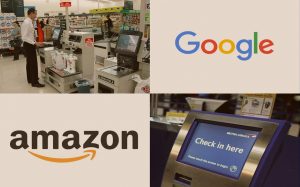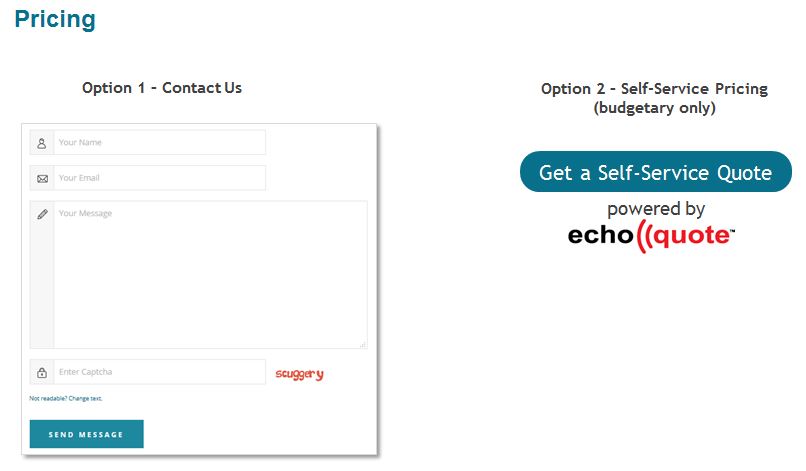The Priceless Call-to-Action
Acquiring B2B Customers in a Self-Service World

We now live in a Self-Service World; a world where the buyer decides when and how they will buy from you.
One of the most controversial decisions for many B2B companies is how to control the dissemination of pricing information, especially in a self-service world. In most cases, companies are inclined to keep pricing information off the website, forcing visitors to “Contact Sales” for pricing.
This practice causes a problem for the prospective buyer, however, because pricing is very important. It helps them understand what you offer before they reach out to sales.
Price is the most specific piece of information customers use to understand the nature of an offering…we have miles of videotape of users asking “Where’s the price?” while tearing their hair out.
Jakob Nielson, Web Usability Expert
Think of your own online experiences. Have you ever visited a website, were interested in what you saw and were curious, “How much is this going to cost me?” Since there was no easy option to find out, you left. You didn’t contact sales. That company may have lost your business, and the money spent getting you there in the first place, without even knowing it.
If pricing curiosity is so powerful, why won’t companies put pricing options on their websites?
When we open a discussion about using pricing curiosity to acquire customers for B2B companies, we almost always get some version of these responses:
1) “It’s not done in our industry”
2) “What happens if my competition sees it?”
3) “Our products are complex and everything is custom, nothing is standard”
4) “Our sales people need to build value before we discuss pricing”
5) “We are an exclusive channel company; only our dealers/resellers give out pricing”
And then finally:
6) “We would never do that”
We’ve heard them all!
However, there are several compelling reasons that hesitant companies and site owners should explore a way to safely provide pricing.
Own the Price Conversation
Here’s the logic: any buyer is trained to search for price as part of any purchase decision, especially in the early stages. They’re CURIOUS. They will continue to search until they find a price. And if it’s not easy to get from your site, you will not be part of the price dialog. If there’s a price conversation going on anyway, don’t you want to be a part of it? It’s up to you to own the price conversation, not hand it over to Google.
Not having an easy way to get pricing from your site cedes the opportunity to your competition — or worse, someone not even affiliated with your industry — to control this crucial aspect of the buying decision.
The goal is to own the price and value dialog of your product or service, so you can provide prospects with the context they need to understand your pricing model.
What About Sticker Shock?
There are tactics you can employ to offset the fear that a prospective customer will experience sticker shock if they receive pricing — another common (and valid) concern.
First, if you are using a tool made for the job, you can provide a range of pricing based on a specific configuration versus a single “List” price. This is one of the best ways to provide a ballpark estimate without knowing all of the details about the customer’s requirements. A range gives your sales team wiggle room and also allows for channel partner pricing to be different.
Second, use testimonials right on the page that speaks to the value of your product or service. Quotes from satisfied clients or buyers who shopped around and decided to purchase your product or service is a powerful strategy. There is an innate sense from buyers that the low-cost provider is never the best, and there is more assumed value in a higher priced product.
Don’t forget the SEO opportunity
Here’s something else we’ve discovered. Ranking for pricing related keywords is easy. Why is that?
No one wants to put pricing options on their site!
This is SEO gold. Highly searched terms with little to no competition means we should all set out to do some keyword research. Check out the terms and phrases in your industry related to “cost” and “price,” and invariably you’ll uncover some huge content opportunities.
In fact, if you adopt a self-service pricing strategy, you should blog about the fact that you provide a way to easily get pricing that your competitors don’t. Your conversions and, more importantly, sales conversations, will soar!
Always use a Pricing Page
![]() You should always have a Pricing page. Make all of the links to that page just say “Pricing”. This simple word leaps out at prospects and they will invariably click on it. Don’t be tempted to use “Request a Quote” or “Get a Quote”, our extensive A/B testing proves that those imply a Sales phone call and are ignored. Even if it doesn’t contain a link to EchoQuote™ (see below), and only has a Contact Us form, you will still get lots of activity to that page.
You should always have a Pricing page. Make all of the links to that page just say “Pricing”. This simple word leaps out at prospects and they will invariably click on it. Don’t be tempted to use “Request a Quote” or “Get a Quote”, our extensive A/B testing proves that those imply a Sales phone call and are ignored. Even if it doesn’t contain a link to EchoQuote™ (see below), and only has a Contact Us form, you will still get lots of activity to that page.
Using a Pricing Call-to-Action tool like EchoQuote™ (optional)
Few marketers realize that there are tools specifically built to exploit the need for pricing by website visitors while safely protecting a company’s pricing. One tool, EchoQuote™, is designed specifically to handle all of the objections in the introduction, and more.
If you are using the EchoQuote™ Marketing edition, you will want to give a prospect two (2) ways to get pricing on your Pricing page: 1) Full Service by filling out a form (like you do now), or 2) Self-Service using EchoQuote™.
Take a close look at this sample Pricing page. Which would you act on?

Expected Results
We’ve captured over 1,000,000 qualified leads using this process for over ten (10) years and have lots of before/after data from customers. On average, the Self-Service Option generates 3-5 times as many qualified leads as a standard Contact Us form.
Summary
The need by prospects for Pricing is stronger than ever, especially now that we live in a self-service world. If you don’t take control of the Pricing conversation, someone else will. You can make small changes like creating content around “cost” and “pricing” to drive more inbound traffic. You should also use a Pricing page to convert the curious visitor to an active prospect.
If you have the option, try using a tool built for the purpose of B2B Lead Conversion. Trial a tool like EchoQuote™ that is built to take in requests, route them to your sales team for approval. You’ll find that you can generate 3-5 times the number of high-quality leads your website captures while owning the price conversation.
In B2B Sales the first company in has the best chance of shaping, and winning, the deal. Using Pricing as a Call-to-Action could be your secret marketing weapon…Priceless!
Good selling!
Additional information:
Case studies on using Pricing as a Call-to-Action for B2B companies here.

